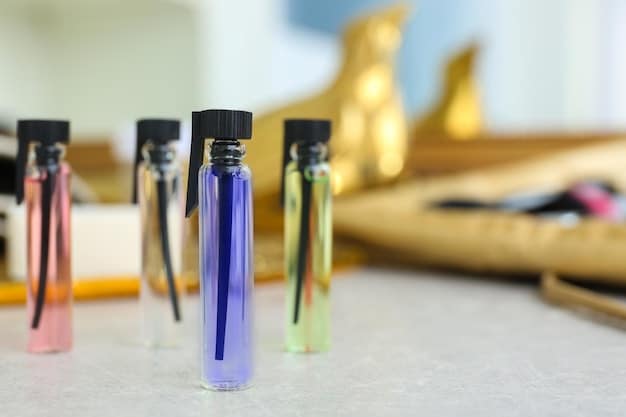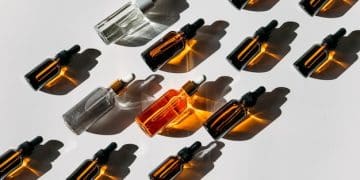Fragrance Clones vs Originals: Performance & Value in the US

Fragrance clones offer a cost-effective alternative to original perfumes, but understanding the nuances of performance, longevity, and overall value is crucial for US consumers making informed purchasing decisions.
Navigating the world of fragrances can be both exciting and overwhelming, especially when considering the price tags of designer perfumes. Fragrance clones vs. originals: A detailed comparison of performance and value in the US market is essential for any fragrance enthusiast or budget-conscious consumer. Let’s dive in.
Understanding Fragrance Clones
Fragrance clones, also known as dupes, are perfumes designed to mimic the scent of popular, often expensive, designer fragrances. They aim to provide a similar olfactory experience at a fraction of the cost. This makes them an attractive option for those who want to enjoy a particular scent profile without breaking the bank.
What Exactly is a Fragrance Clone?
A fragrance clone isn’t just a cheap imitation; it’s a deliberate attempt to recreate the scent of a well-known fragrance using different, often less expensive, ingredients. The goal is to capture the essence and character of the original, even if the composition isn’t identical.
The Appeal of Clones: Cost Savings and Accessibility
The main allure of fragrance clones is their affordability. Designer perfumes can cost hundreds of dollars, while clones often retail for a tenth of the price. This makes luxury scents accessible to a wider audience. But are the cost savings worth the potential compromise in quality and performance?

To better understand why clones continue to grow in popularity, consider these points:
- Accessibility: Clones allow consumers to explore different scent profiles without committing to a full bottle of an expensive original.
- Budget-Friendly: Ideal for everyday wear, saving the original for special occasions.
- Variety: Provides options to experiment with fragrances that might otherwise be out of reach.
In conclusion, understanding fragrance clones involves acknowledging their purpose: to offer affordable alternatives. While they may not perfectly replicate the original, their accessibility and cost-effectiveness continue to drive their popularity in the US market.
The Scent Replication Process
Replicating a fragrance is a complex process that requires skilled perfumers and advanced analytical techniques. Clone manufacturers aim to deconstruct the original scent and recreate it using their own set of ingredients, often with a focus on cost-effectiveness.
Deconstructing the Original Scent
The first step in creating a fragrance clone is to analyze the original perfume’s composition. This involves identifying the various notes, accords, and base components that make up the fragrance’s unique signature. Gas chromatography-mass spectrometry (GC-MS) is a common tool used to identify the chemical compounds present in the original.
Ingredient Selection and Formulation
Once the fragrance profile is understood, clone manufacturers select ingredients that mimic the original’s scent characteristics. This often involves using synthetic aroma chemicals and essential oils that are more cost-effective than the natural extracts used in high-end perfumes. The formulation process involves carefully blending these ingredients to achieve a scent that closely resembles the original.
Challenges in Achieving an Exact Match
Achieving an exact match is challenging due to several factors. The quality and purity of ingredients can vary, and subtle differences in the formulation process can impact the final scent. Additionally, the “nose” of the perfumer plays a crucial role, as their interpretation and blending skills are essential in capturing the essence of the original.

Considerations that impact the scent replication process:
- Ingredient Quality: Lower quality ingredients can result in a less nuanced and shorter-lasting scent.
- Formulation Expertise: The skill of the perfumer is crucial in balancing the different notes and accords.
- Batch Variations: Clones may exhibit slight variations between batches due to differences in ingredient sourcing or manufacturing processes.
In summary, the scent replication process is a delicate balance of science and art. While clone manufacturers strive to create a close approximation of the original, achieving an exact match can be challenging due to ingredient quality, formulation expertise, and batch variations.
Performance: Longevity & Sillage
Performance is a critical aspect when evaluating fragrances. Longevity refers to how long the scent lasts on the skin, while sillage describes the scent’s projection or the trail it leaves behind. These factors can significantly impact the overall wearing experience.
Longevity: Original vs. Clone
Original fragrances often boast superior longevity due to the use of high-quality ingredients and a well-balanced formulation. They can last for several hours, evolving through different stages of notes. Clones, on the other hand, may have shorter longevity due to the use of less concentrated fragrance oils or lower-quality ingredients. They may fade more quickly, requiring reapplication throughout the day.
Sillage: Projection and Scent Trail
Sillage is another differentiating factor. Original fragrances tend to have a more pronounced sillage, creating a noticeable scent trail that garners attention. Clones may have a weaker sillage, staying closer to the skin and requiring closer proximity to be detected. This can be a drawback for those who enjoy making a statement with their fragrance.
Factors Affecting Performance
Several factors can influence fragrance performance, including skin type, weather conditions, and application method. Dry skin, for example, tends to absorb fragrance more quickly, reducing longevity. Hot and humid weather can amplify a fragrance’s projection, while cold weather may diminish it. Applying fragrance to pulse points, such as the wrists and neck, can help improve longevity and sillage.
Key factors affecting performance include:
- Concentration: Higher concentrations, like parfum or eau de parfum, generally offer better longevity and sillage compared to eau de toilette or eau de cologne.
- Ingredient Quality: High-quality ingredients tend to last longer and project better.
- Skin Chemistry: Individual skin chemistry can affect how a fragrance interacts with the skin, impacting its performance.
In conclusion, performance is a key area where original fragrances often outperform clones. While clones may offer a similar scent profile, their longevity and sillage may be less impressive. Understanding these differences can help consumers make informed decisions based on their preferences and needs.
Value: Price vs. Quality
Value is a subjective measure that balances cost and quality. Fragrance clones often excel in terms of price, but assessing their overall value requires considering the quality of the scent, performance, and ingredients.
The Price Advantage of Clones
The lower price point of fragrance clones is undeniably attractive. Consumers can purchase multiple clones for the price of a single original fragrance, allowing them to build a diverse fragrance wardrobe without exceeding their budget. This affordability opens up opportunities to experiment with different scents and find new favorites.
Assessing the Quality Trade-off
However, the cost savings often come with a trade-off in quality. Clones may use synthetic aroma chemicals that lack the complexity and depth of natural extracts found in original fragrances. This can result in a scent that is less nuanced and potentially more artificial-smelling. Additionally, the longevity and sillage may be compromised, requiring more frequent reapplication.
Long-Term Cost Considerations
While the initial cost of a clone may be lower, it’s important to consider long-term cost implications. If a clone requires frequent reapplication, the cost per wear may end up being higher than that of an original fragrance that lasts longer. Additionally, the potential for skin irritation or allergic reactions from lower-quality ingredients should be taken into account.
Consider these cost-benefit analyses when evaluating fragrance value:
- Cost per Wear: Calculate the cost per wear based on the number of applications needed and the total cost of the fragrance.
- Ingredient Sensitivity: Consider potential sensitivities to synthetic ingredients and prioritize fragrances with higher-quality, natural components.
- Scent Satisfaction: Determine if the clone provides a satisfying scent experience that aligns with personal preferences.
In summary, the value proposition of fragrance clones hinges on balancing price and quality. While clones offer significant cost savings, consumers should carefully assess the quality of the scent, performance, and ingredients to determine if the trade-off is justified.
Consumer Reviews and Community Feedback
Consumer reviews and community feedback provide valuable insights into the real-world performance and satisfaction levels of both original fragrances and their clones. These reviews can help consumers make more informed purchasing decisions by offering diverse perspectives and experiences.
Analyzing Online Reviews
Online fragrance communities and review websites are treasure troves of information. Consumers often share their experiences with specific fragrances, detailing their longevity, sillage, and overall scent impressions. Analyzing these reviews can help identify trends and patterns, revealing which clones are highly regarded and which ones fall short of expectations.
Community Recommendations and Discussions
Fragrance communities are also excellent sources of recommendations and discussions. Members often share their favorite clones, compare them to the originals, and offer tips on how to find the best deals. Engaging in these discussions can provide a deeper understanding of the clone market and help consumers discover hidden gems.
Potential Biases and Limitations
It’s important to be aware of potential biases and limitations when relying on consumer reviews. Individual preferences vary widely, and what one person considers a great scent, another may find unpleasant. Additionally, some reviews may be influenced by brand loyalty or promotional incentives. It’s best to consider a wide range of reviews and opinions before making a decision.
Strategies for interpreting consumer reviews include:
- Cross-Reference Reviews: Compare reviews from multiple sources to identify consistent themes and opinions.
- Consider Reviewer Profiles: Evaluate the reviewer’s profile and fragrance preferences to assess their credibility and relevance.
- Focus on Specific Aspects: Look for reviews that address specific aspects, such as longevity, sillage, and scent accuracy.
In conclusion, consumer reviews and community feedback are invaluable resources for navigating the fragrance clone market. By analyzing online reviews, engaging in community discussions, and being aware of potential biases, consumers can make more informed decisions and find clones that meet their expectations.
Making an Informed Choice
Choosing between fragrance clones and originals ultimately depends on individual priorities and preferences. Understanding the factors that differentiate them—such as scent replication, performance, value, and consumer feedback—is crucial for making an informed choice.
Consider Your Priorities
Start by considering what you value most in a fragrance. If you prioritize affordability and variety, clones may be a suitable option. If you prioritize quality, longevity, and a unique scent experience, original fragrances may be a better investment. Also, assess how important the prestige of owning a designer fragrance is to you.
Sample Before You Commit
Whenever possible, sample both the original fragrance and its clone before committing to a full bottle. This allows you to directly compare the scents, assess their performance on your skin, and determine which one you prefer. Many clone manufacturers offer sample sizes or discovery sets, making it easier to try before you buy.
Read Reviews & Ask for Recommendations
Consult online reviews and fragrance communities for recommendations. Other consumers’ experiences can provide valuable insights into the quality and performance of specific clones. Don’t hesitate to ask for recommendations based on your preferred scent profiles or specific original fragrances you admire.
A checklist for making informed fragrance choices:
- Identify Your Preferences: Determine your preferred scent families, notes, and intensity levels.
- Set a Budget: Establish a budget for your fragrance purchases and stick to it.
- Research Reputable Brands: Focus on reputable clone manufacturers known for their quality and accuracy.
- Consider Occasion: Match the fragrance to the occasion, opting for lighter scents for everyday wear and bolder scents for special events.
In summary, making an informed choice between fragrance clones and originals requires careful consideration of your priorities, scent sampling, and research. By weighing the pros and cons of each option, you can find fragrances that align with your preferences, budget, and lifestyle.
| Key Aspect | Brief Description |
|---|---|
| 💰 Cost Savings | Clones offer significant savings compared to originals. |
| ⏳ Longevity | Originals typically last longer on the skin. |
| 🧪 Ingredient Quality | Originals often use higher-quality ingredients. |
| 👃 Scent Accuracy | Clones aim to mimic the original, but may not be exact. |
Frequently Asked Questions
▼
Fragrance clones are perfumes designed to mimic the scent of popular, often expensive, designer fragrances. They offer a similar olfactory experience at a lower price.
▼
Yes, fragrance clones are legal as long as they don’t infringe on any trademarks or patents. They cannot use the same name or branding as the original.
▼
The longevity of fragrance clones can vary, but they generally don’t last as long as original fragrances. Reapplication may be necessary throughout the day.
▼
No, fragrance clones often use different, less expensive ingredients than original fragrances. This can affect the scent quality and longevity.
▼
Fragrance clones are available online through various retailers and directly from clone manufacturers. Some may also be found in discount stores.
Conclusion
In the landscape of fragrances, the choice between original perfumes and their cloned counterparts hinges on individual priorities. While originals often boast superior quality and performance, fragrance clones present a budget-friendly alternative, broadening accessibility to a diverse range of scents for consumers across the US.





